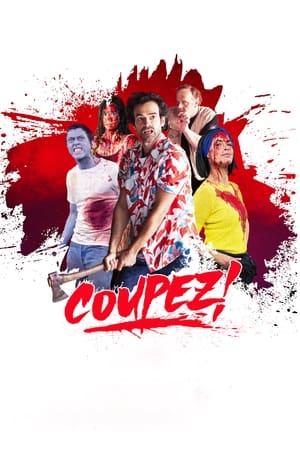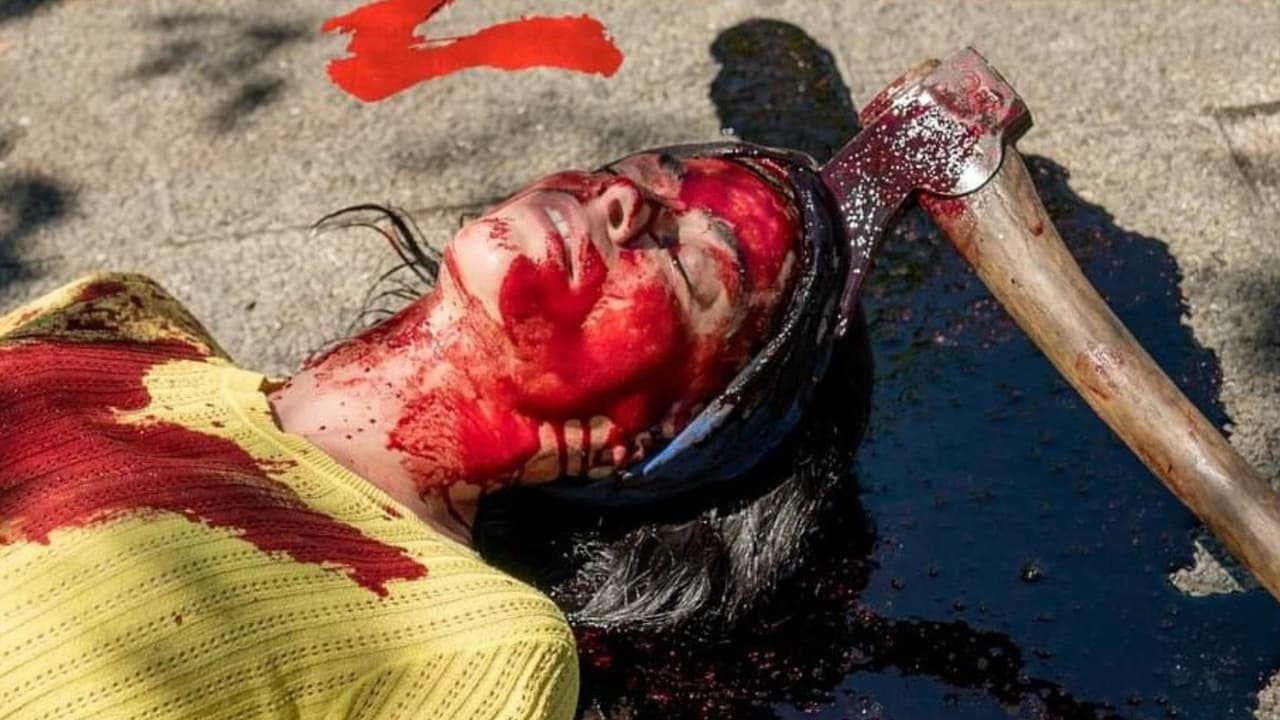
Qui a coupé le fromage?
Final Cut (the original French title is Coupez!) puts me in a bit of a sticky situation. The film—which opened this year’s Cannes Film Festival—is a remake of the 2017 Japanese film One Cut of the Dead (released in France as Ne coupez pas!), which achieved instant (and deserved) cult classic status. That movie tells the story of a production crew working on a low-budget zombie movie which is, in turn, attacked by real zombies. The thing is, that’s not what the film is about; it’s merely the premise. A seismic shift occurs about a third of the way in. While I think the original is strong enough on its own merits, there’s no denying that one of its chief pleasures is getting played by the reveal. There is a real novelty value to it.
Which brings me to the remake. Who, exactly, is this movie for? If you have seen the original, the novelty is gone. If you haven’t, then you are getting a second-hand facsimile of a film that is pretty damn close to being the best version of itself. Pity me, the poor reviewer. Not only do I have to compare the new film to its predecessor, effectively reviewing both at the same time, but I have to do it without spoiling either.
Final Cut, like One Cut, takes two powerful tools from the Pretentious Movie toolbox: It is a metafiction, and its long opening segment is filmed (or edited to seem like it is filmed) in a single take. Put those two things together, and you get 1) Birdman, or something like it; and 2) a boatload of Oscars. Heck, director Michel Hazanavicius’ best-known film, 2011’s The Artist, already combined metafiction and gimmickry (in that case, silent cinema) to reap Oscar gold. One Cut, however, is not pretentious at all, while Final Cut is only slightly more so, because it’s in French and has two big French stars (Romain Duris and Bérénice Bejo) attached to it. It does everything else it can, though, to retain the charm of the original.
And that’s a huge problem! Because—and this is only a slight exaggeration—the two films are exactly the same. The same set-up. The same relationship between the director and his cast. The same jokes, with some cosmetic changes (“Pom!” is now Krav Maga). Every plot beat is also the same: the camera on the ground; the weird, half-seen entity lurking in the shed; the ill-timed vomit and diarrhea, etc.
Now, I did say this was a slight exaggeration, because some things are different. After the grisly first act comes to a close (faster than the original, I might add, although the overall film is somehow longer), the film cuts for the first time to an extended flashback explaining how the doomed production came to be. Before long, we are introduced to the most memorable face from the original: Takehara "Donguri" Yoshiko, reprising the same role (but not, technically, the same character) she played in One Cut, a producer looking to recruit Duris’ journeyman director to usher into the world a short promotional film intended to advertise their new zombie movie service, Channel Z. In fact, she is trying to export a service that has already found great success in Japan. Later on, Duris’ character is seen watching the original One Cut of the Dead.
So this film is pretending to exist in the same continuity as the first film, which is absurd. The producers—I suppose it’s identical twins working on the same zombie channel—might wonder how they ended up financing two films that went belly-up in the exact same way. The entire segment becomes a sort of meta-commentary on how this is a French remake of a Japanese film. As happy as I was to see Donguri again (I guess they must give something to fans of the original), it was frankly a distraction, an unpleasant reminder that the film before us is derivative of something better. It does, at least, squeeze some new jokes out of the altered scenario. The actors are contractually obliged to keep the original script, including the Japanese names, which the actors then struggle to remember. It’s a small gag, but at least it’s new.
There are other changes, both welcome and unwelcome. Jean-Pascal Zadi plays the film crew’s goofball musician, and there are some amusing bits involving the use of non-diegetic music that turns out to be diegetic. His character doesn’t amount to much, however. It feels like a slow build-up to a joke that ultimately never happens.
Most unwelcome is the film’s Tarantino fetish. Duris is dressed to vaguely resemble the popular director, while Bejo—who plays Duris’ wife, inserted into the zombie film at the last possible moment—wears a wig designed to make her look like Uma Thurman in Pulp Fiction. The resemblances are evident to anyone who has eyes, but for those who don’t, they are also lampshaded in dialogue to make sure you get it. The film-within-in-a-film looks like a gritty “grindhouse” feature from the 70s, which of course is another homage to the director.
Yet another bit of handholding occurs during an emotional moment near the end, where the director and his daughter (wearing, at one point, a “Directed by Quentin Tarantino” T-shirt) inadvertently recreate a photograph from her childhood seen earlier in the film. In the event that we, the audience, suffered a memory lapse of something we saw less than a half-hour ago, Duris then pulls out the photo and remarks how they look the same!
Good source material does not always make for a good movie (playing on Netflix now: adaptations of Persuasion and Dangerous Liaisons), but, in this case, the copy is sufficiently close to its model that it shares its strengths. Knowing everything in advance, I still laughed a lot. But if this happens to be your entry point into the One Cut cinematic universe, boy, do I feel bad for you!
Gavin McDowell is a Hoosier by birth and French by adoption. He received his doctorate in “Languages, History, and Literature of the Ancient World from the Beginning until Late Antiquity” and is currently investigating Aramaic translations of the Bible. He is supremely unqualified to talk about film. For more of his unprovoked movie opinions, see his Letterboxd account.
Which brings me to the remake. Who, exactly, is this movie for? If you have seen the original, the novelty is gone. If you haven’t, then you are getting a second-hand facsimile of a film that is pretty damn close to being the best version of itself. Pity me, the poor reviewer. Not only do I have to compare the new film to its predecessor, effectively reviewing both at the same time, but I have to do it without spoiling either.
Final Cut, like One Cut, takes two powerful tools from the Pretentious Movie toolbox: It is a metafiction, and its long opening segment is filmed (or edited to seem like it is filmed) in a single take. Put those two things together, and you get 1) Birdman, or something like it; and 2) a boatload of Oscars. Heck, director Michel Hazanavicius’ best-known film, 2011’s The Artist, already combined metafiction and gimmickry (in that case, silent cinema) to reap Oscar gold. One Cut, however, is not pretentious at all, while Final Cut is only slightly more so, because it’s in French and has two big French stars (Romain Duris and Bérénice Bejo) attached to it. It does everything else it can, though, to retain the charm of the original.
And that’s a huge problem! Because—and this is only a slight exaggeration—the two films are exactly the same. The same set-up. The same relationship between the director and his cast. The same jokes, with some cosmetic changes (“Pom!” is now Krav Maga). Every plot beat is also the same: the camera on the ground; the weird, half-seen entity lurking in the shed; the ill-timed vomit and diarrhea, etc.
Now, I did say this was a slight exaggeration, because some things are different. After the grisly first act comes to a close (faster than the original, I might add, although the overall film is somehow longer), the film cuts for the first time to an extended flashback explaining how the doomed production came to be. Before long, we are introduced to the most memorable face from the original: Takehara "Donguri" Yoshiko, reprising the same role (but not, technically, the same character) she played in One Cut, a producer looking to recruit Duris’ journeyman director to usher into the world a short promotional film intended to advertise their new zombie movie service, Channel Z. In fact, she is trying to export a service that has already found great success in Japan. Later on, Duris’ character is seen watching the original One Cut of the Dead.
So this film is pretending to exist in the same continuity as the first film, which is absurd. The producers—I suppose it’s identical twins working on the same zombie channel—might wonder how they ended up financing two films that went belly-up in the exact same way. The entire segment becomes a sort of meta-commentary on how this is a French remake of a Japanese film. As happy as I was to see Donguri again (I guess they must give something to fans of the original), it was frankly a distraction, an unpleasant reminder that the film before us is derivative of something better. It does, at least, squeeze some new jokes out of the altered scenario. The actors are contractually obliged to keep the original script, including the Japanese names, which the actors then struggle to remember. It’s a small gag, but at least it’s new.
There are other changes, both welcome and unwelcome. Jean-Pascal Zadi plays the film crew’s goofball musician, and there are some amusing bits involving the use of non-diegetic music that turns out to be diegetic. His character doesn’t amount to much, however. It feels like a slow build-up to a joke that ultimately never happens.
Most unwelcome is the film’s Tarantino fetish. Duris is dressed to vaguely resemble the popular director, while Bejo—who plays Duris’ wife, inserted into the zombie film at the last possible moment—wears a wig designed to make her look like Uma Thurman in Pulp Fiction. The resemblances are evident to anyone who has eyes, but for those who don’t, they are also lampshaded in dialogue to make sure you get it. The film-within-in-a-film looks like a gritty “grindhouse” feature from the 70s, which of course is another homage to the director.
Yet another bit of handholding occurs during an emotional moment near the end, where the director and his daughter (wearing, at one point, a “Directed by Quentin Tarantino” T-shirt) inadvertently recreate a photograph from her childhood seen earlier in the film. In the event that we, the audience, suffered a memory lapse of something we saw less than a half-hour ago, Duris then pulls out the photo and remarks how they look the same!
Good source material does not always make for a good movie (playing on Netflix now: adaptations of Persuasion and Dangerous Liaisons), but, in this case, the copy is sufficiently close to its model that it shares its strengths. Knowing everything in advance, I still laughed a lot. But if this happens to be your entry point into the One Cut cinematic universe, boy, do I feel bad for you!
Gavin McDowell is a Hoosier by birth and French by adoption. He received his doctorate in “Languages, History, and Literature of the Ancient World from the Beginning until Late Antiquity” and is currently investigating Aramaic translations of the Bible. He is supremely unqualified to talk about film. For more of his unprovoked movie opinions, see his Letterboxd account.
Categories: french cinema, needless remakes






